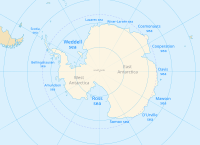
Photo from wikipedia
Continental runoff, inflowing to Arctic waters, is estimated by the use of isotope and hydrophysical tracers. This is quite a complicated task, because desalinated waters freeze. The existing model of… Click to show full abstract
Continental runoff, inflowing to Arctic waters, is estimated by the use of isotope and hydrophysical tracers. This is quite a complicated task, because desalinated waters freeze. The existing model of three-component mixing [1] deals only with the input of melted sea ice, thus limiting its utility in zones where ice is intensely formed. A new mixing-modification model is proposed. The effect of the model is illustrated by data from the Laptev Sea shelf, which is affected by the Lena River runoff. Modification of these waters is manifested by an excessive increase in salinity in relation to the oxygen isotope composition, which is determined by the mixing of waters of the Lena River with waters of the Arctic basin. The model considers the water modification owing to the formation and removal of ice.
Journal Title: Doklady Earth Sciences
Year Published: 2019
Link to full text (if available)
Share on Social Media: Sign Up to like & get
recommendations!